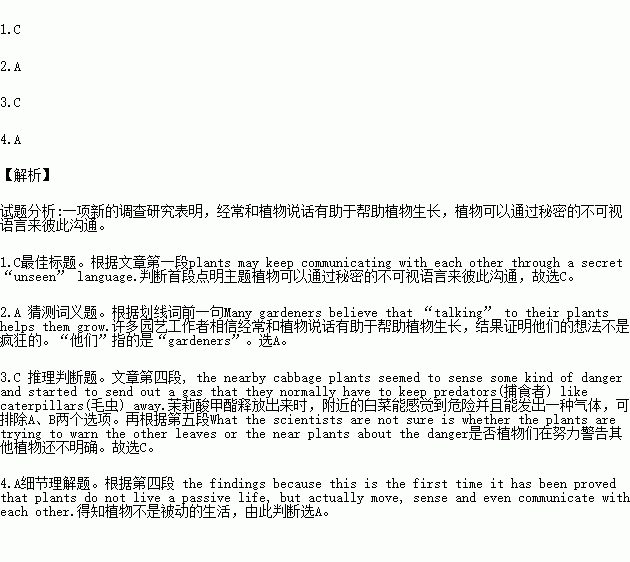题目内容
Many gardeners believe that “talking” to their plants helps them grow---it turns out that they may not be crazy after all. According to the scientists from the University of Exeter, plants may keep communicating with each other through a secret “unseen” language.
For their experiment, the scientists picked a cabbage plant that is known to send out a gas when its surface is cut. In order to get video evidence of the communication, they changed the cabbage gene by adding the protein---luciderase(虫荧光素酶), which is what makes fireflies(萤火虫) glow in the dark.
When the changed cabbage plant was in full bloom, they cut a leaf off with a pair of scissors, and almost immediately, thanks to the luciderase, they could see the plant sending out “methyl jasmonate(茉莉酸甲酯)”.
While this was a known fact, what was surprising was the fact that the minute this gas began to give out, the nearby cabbage plants seemed to sense some kind of danger and started to send out a gas that they normally have to keep predators(捕食者) like caterpillars(毛虫) away.
What the scientists are not sure is whether the plants are trying to warn the other leaves or the near plants about the danger---something that will require further research However, the team, which is led by Professor Nick Smirnoff, is quite excited about the findings because this is the first time it has been proved that plants do not live a passive life, but actually move, sense and even communicate with each other.
However, before you get all concerned, they are quite sure that plants do not feel the pain when they are cut, since they do not have nerves---so go ahead and bite into that juicy carrot!
1.What’s the best title of the passage?
A. Plants Can Send Some Gas
B. Plants Can Communicate with Each Other
C. The “Unseen” Language of Plants
D. Plants Can’t Feel Pain
2. What does the underlined word “they” in Paragraph 1 mean?
A. Gardeners B. Plants
C. Scientists D. Fireflies
3.When the plant sent out methyl jasmonate, which of the following statements is NOT TRUE?
A. The nearby cabbage plants seemed to sense some kind of danger.
B. The nearby cabbage plants started to send out a gas.
C. The nearby cabbage plants tried to warn the near plants.
D. The nearby cabbage plants communicated through a secret language.
4.According to the experiment, plants ________________.
A. don’t live a passive life
B. can feel pain when they are cut
C. can warn the other leaves about danger
D. can talk with each other

